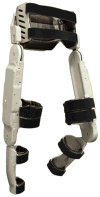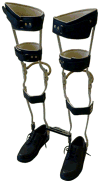A preliminary assessment of legged mobility provided by a lower limb exoskeleton for persons with paraplegia
- PMID: 23797285
- PMCID: PMC4476394
- DOI: 10.1109/TNSRE.2013.2268320
A preliminary assessment of legged mobility provided by a lower limb exoskeleton for persons with paraplegia
Abstract
This paper presents an assessment of a lower limb exoskeleton for providing legged mobility to people with paraplegia. In particular, the paper presents a single-subject case study comparing legged locomotion using the exoskeleton to locomotion using knee-ankle-foot orthoses (KAFOs) on a subject with a T10 motor and sensory complete injury. The assessment utilizes three assessment instruments to characterize legged mobility, which are the timed up-and-go test, the Ten-Meter Walk Test (10 MWT), and the Six-Minute Walk Test (6 MWT), which collectively assess the subject's ability to stand, walk, turn, and sit. The exertion associated with each assessment instrument was assessed using the Physiological Cost Index. Results indicate that the subject was able to perform the respective assessment instruments 25%, 70%, and 80% faster with the exoskeleton relative to the KAFOs for the timed up-and-go test, the 10 MWT, and the 6 MWT, respectively. Measurements of exertion indicate that the exoskeleton requires 1.6, 5.2, and 3.2 times less exertion than the KAFOs for each respective assessment instrument. The results indicate that the enhancement in speed and reduction in exertion are more significant during walking than during gait transitions.
Figures








References
-
- Brown-Triolo DL, Roach MJ, Nelson K, Triolo RJ. Consumer perspectives on mobility: Implications for neuroprosthesis design. J Rehabil Res Develop. 2002;39(6) - PubMed
-
- Phillips L, Ozer M, Axelson P, Fonseca J. Spinal Cord Injury: A Guide for Patient and Family. San Diego, CA: Raven Press; 1987.
-
- Audu ML, To CS, Kobetic R, Triolo RJ. Gait evaluation of a novel hip constraint orthosis with implication for walking in paraplegia. IEEE Trans Neural Syst Rehabil Eng. 2010 Dec;18(6):610–618. - PubMed
-
- Kobetic R, To CS, Schnellenberger JR, Audu ML, Bulea TC, Gaudio R, Pinault G, Tashman S, Triolo RJ. Development of hybrid orthosis for standing, walking, and stair climbing after spinal cord injury. J Rehabil Res Develop. 2009;43:447–462. - PubMed
-
- To CS, Kobetic R, Schnellenberger JR, Audu ML, Triolo RJ. Design of a variable constraint hip mechanism for a hybrid neuroprosthesis to restore gait after spinal cord injury. IEEE/ASME Trans Mechatron. 2008 Apr;13(2):197–205.
Publication types
MeSH terms
Grants and funding
LinkOut - more resources
Full Text Sources
Other Literature Sources
Medical
Research Materials

